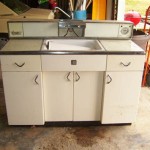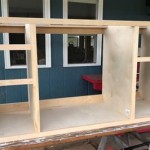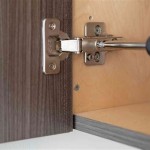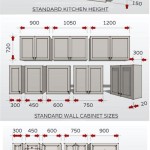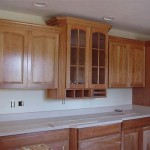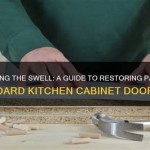How To Fix Bottom Of Cabinet Water Damage
Water damage to the bottom of kitchen or bathroom cabinets is a common household problem. It often stems from leaks in plumbing, spills, or condensation. Addressing this damage promptly is crucial to prevent further deterioration, mold growth, and potential structural issues. This article provides a comprehensive guide on how to identify, assess, and repair water damage to cabinet bottoms.
The first step in addressing water-damaged cabinets is to pinpoint the source of the leak. Common culprits include leaky pipes under the sink, a faulty dishwasher, or a refrigerator with a malfunctioning ice maker. Failure to identify and repair the source will render any repair efforts futile, as the damage will simply recur.
Before initiating any repair work, it is essential to gather the necessary tools and materials. These may include: a screwdriver, a wrench, a moisture meter, a shop vacuum, cleaning supplies (bleach, disinfectant), paint scraper/putty knife, sandpaper, wood filler or epoxy, primer, paint or stain, safety glasses, gloves, and a respirator or dust mask.
Safety should always be a priority. When working with potentially mold-affected materials, wearing safety glasses, gloves, and a respirator is highly recommended. Ensure the work area is well-ventilated to minimize exposure to airborne particles and fumes. Disconnect any electrical appliances near the affected area before beginning the repair process, and turn off the water supply to the sink or appliance to prevent additional water damage.
Identifying and Assessing Water Damage
Identifying water damage requires careful inspection of the cabinet's interior and exterior surfaces. Visible signs often include discoloration, staining, bubbling or peeling paint, and warping or swelling of the wood. A musty odor is also a strong indication of water damage and potential mold growth. Even if visible signs are subtle, use a moisture meter to accurately assess the moisture content of the wood. A reading above 16-20% indicates an elevated moisture level and suggests water damage is present.
To further assess the extent of the damage, probing the affected areas with a screwdriver or putty knife can reveal soft or rotted wood. Areas that easily crumble or flake away are indicative of significant water damage. It's important to check adjacent cabinets and flooring as well, as water can migrate and cause damage to nearby surfaces.
Differentiating between minor surface damage and more extensive structural damage is critical for determining the appropriate repair strategy. Minor surface blemishes may only require cleaning, sanding, and refinishing. However, if the wood is significantly warped, rotted, or structurally compromised, more extensive repairs or even replacement of the affected cabinet components may be necessary.
Consider the type of cabinet material when assessing the damage. Solid wood cabinets are generally more resistant to water damage than particleboard or MDF (medium-density fiberboard) cabinets. Particleboard and MDF are highly absorbent and tend to swell and disintegrate rapidly when exposed to moisture. Repairs to these materials are often less effective than repairs to solid wood.
Repairing Minor Water Damage
For minor water damage, the repair process generally involves cleaning, sanding, and refinishing the affected area. Start by thoroughly cleaning the cabinet interior with a mild detergent solution and water. For areas suspected of mold growth, use a bleach solution (mix one part bleach with ten parts water) to disinfect the surface. Always wear gloves and eye protection when working with bleach.
Once the area is clean and dry, use sandpaper to remove any loose paint, varnish, or damaged wood fibers. Start with a coarser grit sandpaper (e.g., 80-grit) to remove the bulk of the damage, then gradually move to finer grits (e.g., 120-grit, 220-grit) to smooth the surface. Feather the edges of the sanded area to blend it seamlessly with the surrounding finish.
If there are any minor dents or imperfections in the wood, use a wood filler or epoxy to fill them in. Follow the manufacturer's instructions for mixing and applying the filler. Allow the filler to dry completely before sanding it smooth. Apply a wood primer to the cleaned and sanded area to ensure proper adhesion of the finish coat.
Finally, apply a paint or stain that matches the existing cabinet finish. Multiple thin coats are preferable to one thick coat, as this will prevent runs and drips. Allow each coat to dry completely before applying the next. Consider applying a clear topcoat to protect the finish and enhance its durability.
Ensure proper ventilation during the cleaning, sanding, and finishing process. Use a respirator or dust mask to avoid inhaling harmful particles and fumes. Allow the repaired area to dry completely before placing items back inside the cabinet.
Addressing Extensive Water Damage
Extensive water damage often necessitates more significant repairs, potentially involving the replacement of damaged cabinet components. If the bottom of the cabinet is severely warped, rotted, or structurally unsound, replacing it may be the most effective solution. This can be accomplished by carefully removing the damaged bottom and replacing it with a new piece of wood cut to the exact dimensions. Secure the new bottom using wood glue and screws or nails.
For cabinets made of particleboard or MDF, replacement is often the only viable option when significant water damage is present. These materials do not hold up well to moisture and are difficult to repair effectively. Consider replacing the entire cabinet or only the damaged components, depending on the severity of the damage and the availability of replacement parts.
If mold growth is extensive, it is crucial to consult with a professional mold remediation service. Mold spores can be harmful to health, and professional remediation ensures that the mold is properly removed and the affected area is thoroughly cleaned and disinfected. Trying to remove extensive mold growth without proper training and equipment can spread the spores and worsen the problem.
When replacing cabinet components, ensure that the new materials are properly sealed to prevent future water damage. Apply a waterproof sealant to all edges and seams to create a moisture barrier. Consider using marine-grade plywood for cabinet bottoms that are particularly susceptible to water exposure, such as those under sinks.
After completing the repairs, it is essential to monitor the area for any signs of recurring water damage. Regularly check for leaks, condensation, or other moisture issues. Addressing any potential problems promptly will prevent further damage and ensure the longevity of the cabinet.
Maintaining proper ventilation under the sink can also help to prevent moisture buildup. Avoid storing damp items under the sink, and consider using a dehumidifier in humid environments. Regularly inspect plumbing connections and replace any worn or damaged components as needed.
Preventative measures are key to minimizing the risk of water damage to cabinets. Promptly address any leaks or spills, and take steps to minimize condensation. By taking these precautions, the lifespan of kitchen and bathroom cabinets can be extended and the costs associated with water damage repairs can be reduced.

Repairing A Water Damaged Sink Base Cabinet Floor

How To Replace That Old Rotted Out Sink Base Floor Step By

How Do I Repair My Water Damaged Sink Cabinet Hometalk

Water Damage Repair Wood Under The Kicthen Sink Cabinet

How To Repair Water Damaged Cabinet

Fixing A Water Damaged Cabinet Base Underneath Kitchen Sink

How To Replace Water Damaged Cabinet Bottom

Rotted Sink Cabinet Floor How To Fix

Discover Everything You Need To Know About Cabinet Repair

How To Repair A Water Damaged Cabinet 2025 Today S Homeowner
Related Posts

